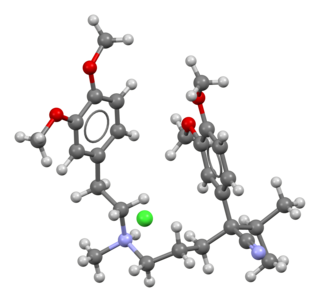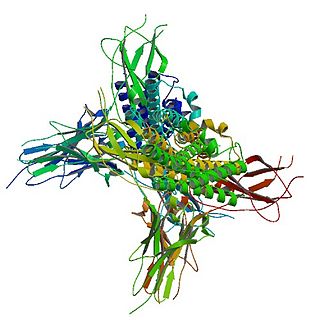
Lidocaine, also known as lignocaine and sold under the brand name Xylocaine among others, is a local anesthetic of the amino amide type. It is also used to treat ventricular tachycardia. When used for local anaesthesia or in nerve blocks, lidocaine typically begins working within several minutes and lasts for half an hour to three hours. Lidocaine mixtures may also be applied directly to the skin or mucous membranes to numb the area. It is often used mixed with a small amount of adrenaline (epinephrine) to prolong its local effects and to decrease bleeding.

Verapamil, sold under various trade names, is a calcium channel blocker medication used for the treatment of high blood pressure, angina, and supraventricular tachycardia. It may also be used for the prevention of migraines and cluster headaches. It is given by mouth or by injection into a vein.

Filgrastim, sold under the brand name Neupogen among others, is a medication used to treat low neutrophil count. Low neutrophil counts may occur with HIV/AIDS, following chemotherapy or radiation poisoning, or be of an unknown cause. It may also be used to increase white blood cells for gathering during leukapheresis. It is given either by injection into a vein or under the skin. Filgrastim is a leukocyte growth factor.

Pilocarpine is a medication used to reduce pressure inside the eye and treat dry mouth. As an eye drop it is used to manage angle closure glaucoma until surgery can be performed, ocular hypertension, primary open angle glaucoma, and to constrict the pupil after dilation. However, due to its side effects it is no longer typically used for long-term management. Onset of effects with the drops is typically within an hour and lasts for up to a day. By mouth it is used for dry mouth as a result of Sjögren syndrome or radiation therapy.

Sulfasalazine, sold under the brand name Azulfidine among others, is a medication used to treat rheumatoid arthritis, ulcerative colitis, and Crohn's disease. It is considered by some to be a first-line treatment in rheumatoid arthritis. It is taken by mouth or can be administered rectally.

Bupivacaine, marketed under the brand name Marcaine among others, is a medication used to decrease feeling in a specific area. In nerve blocks, it is injected around a nerve that supplies the area, or into the spinal canal's epidural space. It is available mixed with a small amount of epinephrine to increase the duration of its action. It typically begins working within 15 minutes and lasts for 2 to 8 hours.

Enoxaparin sodium, sold under the brand name Lovenox among others, is an anticoagulant medication. It is used to treat and prevent deep vein thrombosis (DVT) and pulmonary embolism (PE) including during pregnancy and following certain types of surgery. It is also used in those with acute coronary syndrome (ACS) and heart attacks. It is given by injection just under the skin or into a vein. It is also used during hemodialysis.

Timolol is a beta blocker medication used either by mouth or as eye drops. As eye drops it is used to treat increased pressure inside the eye such as in ocular hypertension and glaucoma. By mouth it is used for high blood pressure, chest pain due to insufficient blood flow to the heart, to prevent further complications after a heart attack, and to prevent migraines.

Tobramycin is an aminoglycoside antibiotic derived from Streptomyces tenebrarius that is used to treat various types of bacterial infections, particularly Gram-negative infections. It is especially effective against species of Pseudomonas.

Chloroprocaine is a local anesthetic given by injection during surgical procedures and labor and delivery. Chloroprocaine vasodilates; this is in contrast to cocaine which vasoconstricts. Chloroprocaine is an ester anesthetic.

Tropicamide, sold under the brand name Mydriacyl among others, is a medication used to dilate the pupil and help with examination of the eye. Specifically it is used to help examine the back of the eye. It is applied as eye drops. Effects occur within 40 minutes and last for up to a day.
Insulin detemir, sold under the brand name Levemir among others, is a long-acting modified form of medical insulin used to treat both type 1 and type 2 diabetes. It is used by injection under the skin. It is effective for up to 24 hours.

Palonosetron, sold under the brand name Aloxi, is used for the prevention and treatment of chemotherapy-induced nausea and vomiting (CINV). It is a 5-HT3 antagonist.

Tiotropium bromide, sold under the brand name Spiriva among others, is a long-acting bronchodilator used in the management of chronic obstructive pulmonary disease (COPD) and asthma. Specifically it is used during periods of breathing difficulty to prevent them from getting worse, rather than to prevent them from happening. It is used by inhalation through the mouth. Onset typically begins within half an hour and lasts for 24 hours.
Telmisartan/hydrochlorothiazide, sold under the brand name Micardis HCT among others, is a fixed-dose combination medication used to treat high blood pressure. It is a combination of telmisartan an angiotensin II receptor antagonist with hydrochlorothiazide a diuretic. It may be used if telmisartan by itself is not sufficient. It is taken by mouth.

Intravenous sodium bicarbonate, also known as sodium hydrogen carbonate, is a medication primarily used to treat severe metabolic acidosis. For this purpose it is generally only used when the pH is less than 7.1 and when the underlying cause is either diarrhea, vomiting, or the kidneys. Other uses include high blood potassium, tricyclic antidepressant overdose, and cocaine toxicity as well as a number of other poisonings. It is given by injection into a vein.
Idarucizumab, sold under the brand name Praxbind, is a monoclonal antibody used as a reversal agent for dabigatran.
Polatuzumab vedotin, sold under the brand name Polivy, is a CD79b-directed antibody-drug conjugate medication used for the treatment of diffuse large B-cell lymphoma (cancer). It was developed by the Genentech subsidiary of Roche.
Beclometasone/formoterol, sold under the brand name Fostair, is an inhalable fixed-dose combination drug for the treatment of asthma and chronic obstructive pulmonary disease (COPD). It contains beclometasone dipropionate and formoterol fumarate dihydrate. It is inhaled.














